Graphs and comments on this page relate to the average reliability of IBP/NCDXF 28 MHz beacons determined in the UK during 1998, the results of monitoring by members of the Six and Ten Reporting Club. Reliability in these graphs is a 3-month running average of the percentage of days per month when each beacon was heard. Beacons are ranked by average annual reliability over the period March-December 1998 with the most reliable (most frequently heard) at the top of the page.
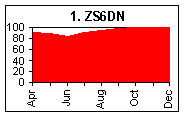 |
ZS6DN was the most reliable IBP beacon in the UK, being heard at sometime on every day in the last three months of 1998 (100% reliability). As with other South African beacons (ZS6PW, ZS1LA, ZS1J), this reliability is due to a favourable location south of the UK. Monitoring of ZS6PW by G2AHU provides an excellent and more detailed view of propagation from South Africa. |
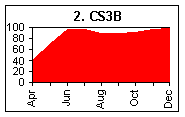 |
CS3B on Madeira is at one-hop F-layer distance from the UK, lies to the south, and is in range for summertime sporadic E (Es). This explains the overall high reliability with the June-July peak due to the contribution from Es. |
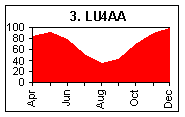 |
With third highest reliability overall, LU4AA also benefits from a location in the southern hemisphere. The dip in the late summer months is only partly due to expected seasonal changes as the beacon also suffered some outages (transmit failures) during this period. |
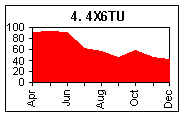 |
The Tel Aviv beacon has been experiencing intermittent problems and this more than any propagation effects accounts for the poor performance in the latter half of the year. However 4X6TU still ranks fourth overall from results in the first part of the year - this due to its location within one F-layer hop of the UK. |
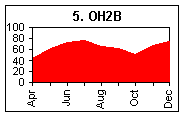 |
OH2B shows a two-peak distribution with that of the summer months resulting almost entirely from sporadic E. With recent increases in solar activity, the ionosphere permits shorter F-layer skip distances such as between this Finnish beacon and southern England. In addition F-layer backscatter has also contributed to the winter-month improvement in reliability. |
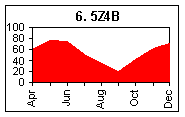 |
The 5Z4B beacon is another that has suffered technical problems. The dip centred in September is due to the beacon being off-air for about three months. Despite this, Kenya is clearly a good location for 10m propagation to the UK as 5Z4B still made it to sixth place in the overall reliability rankings. |
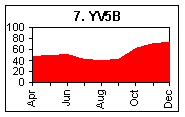 |
The beacon in Venezuela showed a steady improvement in reliability over the year with a boost in June due to a small but significant contribution from multi-hop trans-Atlantic sporadic E. |
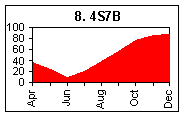 |
Markedly improved propagation to Sri Lanka and the Indian sub-continent generally due to increasing solar activity of solar cycle 23 might be the interpretation of these results. While propagation improvements have certainly occurred, the 4S7B beacon was off-air in May and June and this has considerably exaggerated the effect in the graph. |
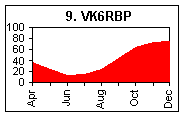 |
The Western Australian beacon VK6RBP provides an excellent view of the increase in propagation efficiency coupled with seasonal effects. VK6RBP is distant from the UK but as the path is largely north-south it supports 10m contacts more frequently than some might expect (80% of days in January 1999). |
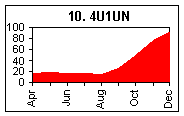 |
The steep rise in propagation reliability to the east coast of the United States in the latter half of the year is the result of increasing solar activity coupled with the normal seasonal improvements expected at this time of year. The flat response during the summer is due to a small number of trans-Atlantic sporadic E openings without which reliabilities of 4U1UN would have reached zero. |
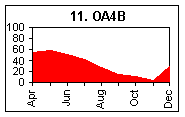 |
OA4B has been virtually (but not entirely) absent from the logs of UK beacon monitors in recent months, although the beacon was not marked as being off-air by NCDXF. In January 1999 OA4B returned to fully-active status and this is reflected in the jump of the 3-month running average for December. |
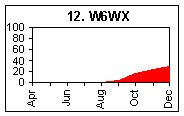 |
W6WX appeared in the UK for the first time in the autumn (fall) of 1998 and since has been heard on a gradually more frequent basis. 28 MHz openings to the US west coast are still uncommon and this beacon has proven a very useful indicator. |
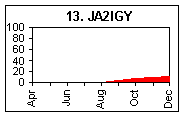 |
Openings to Japan occur less frequently than for California (W6WX) because the path to the UK has a greater northerly component. This is reflected in the graph for JA2IGY which has the same shape as that for W6WX but at lower reliability levels |
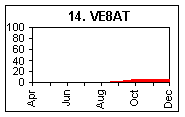 |
VE8AT is awaiting transfer to its high Arctic site but has been transmitting from a temporary site in Alberta. Though NCDXF states the beacon has been off-air in recent months there have been a few reports (possibly in error?) of VE8AT in the UK. This beacon will prove of great interest for aurora and auroral-E propagation studies when finally located. |
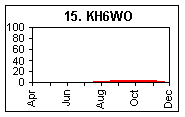 |
In the early autumnal equinoctial period there were a few early morning long path (over the South Pole) openings between the central Pacific and the UK. A number of these opening were identified by reception of signals from KH6WO in Hawaii usefully alerting amateurs to unusual conditions that would probably otherwise have been missed. |
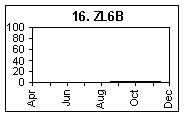 |
Propagation to New Zealand has been slightly better that this graph suggests because the beacon recently lost its antenna in a storm! Moderate to high solar activity is normally required to support propagation to the antipodes, but these conditions have been met and ZL6B should now be heard on a regular basis. |
Two remaining beacons in the IBP chain have not yet been set up - these will be in Russia (central Siberia) and China (Hong Kong).
This site includes a table of beacon transmit times and frequencies and other 10m beacon reports. For more information on the IBP/NCDXF beacons check the NCDXF web site.